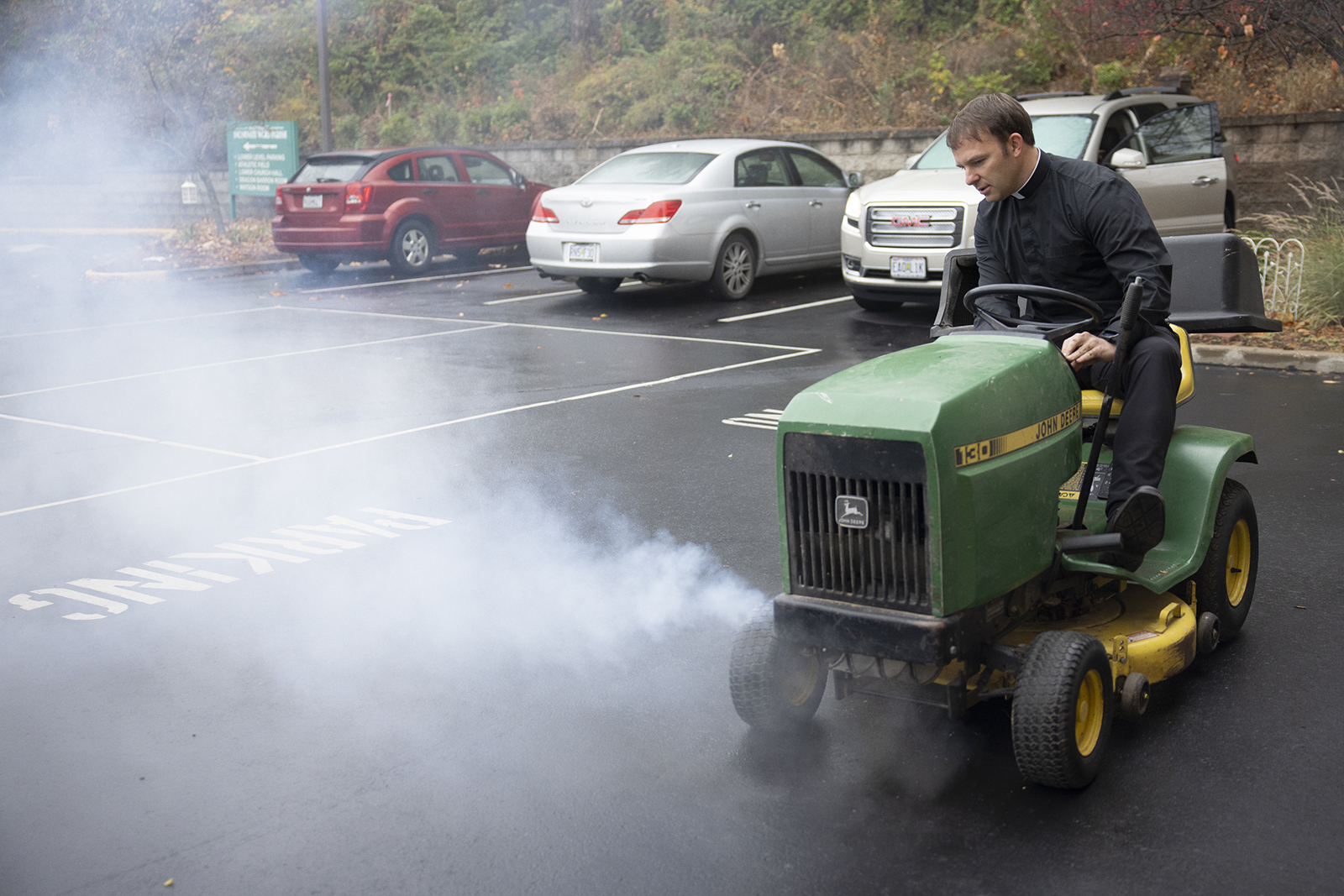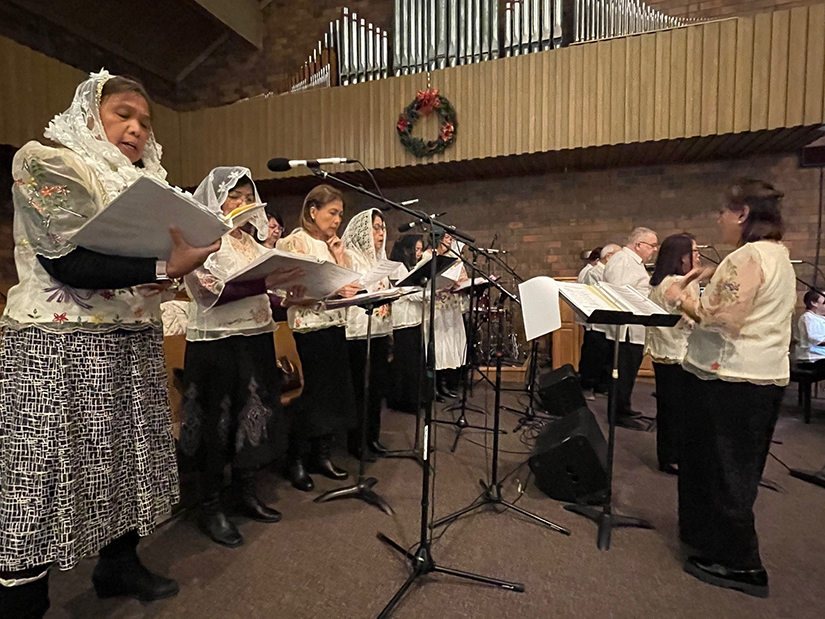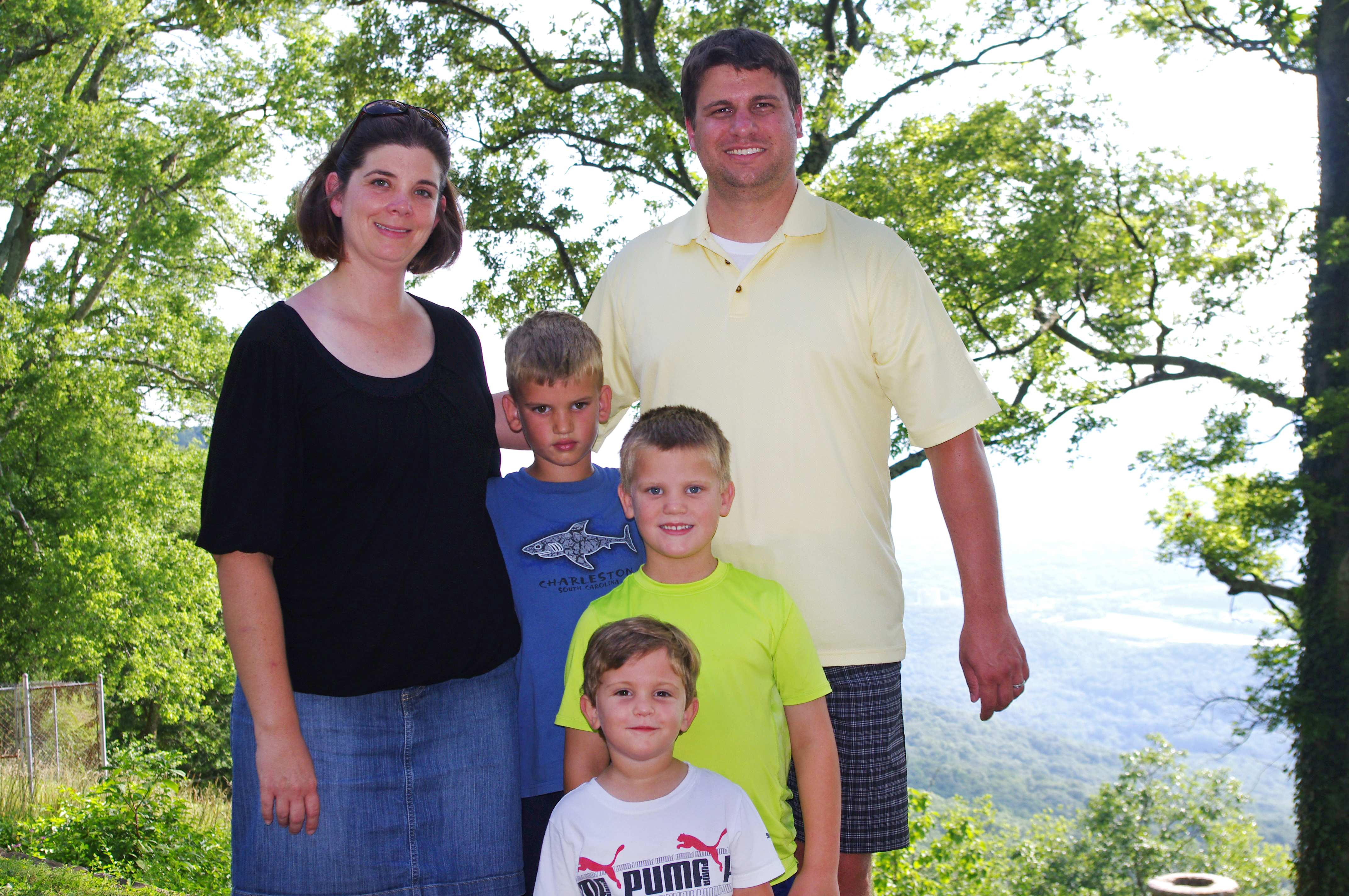Prayer alive in the home

Catholic mom recommends hands-on ways to keep toddlers engaged in prayer, faith
PART 1: Seeing faith as their own
Jessica Fluty believes that it’s important for her young boys ages 2-7 (with one on the way, due in January) to see the faith as their own from an early age.
“I want them to know that Church is home and it’s comfortable and to know that they belong,” said the member of St. Clare of Assisi Parish in Ellisville.
That’s why Jessica also believes encouraging prayer in the home from a young age is equally important. She offers several ideas for encouraging prayer with toddler-age children:
Pray with the saints: All of the Fluty children have been given a patron saint, as well as a special title for Our Lady, that they can pray to. “When they see us praying specifically to their saints and Our Lady, they know that these are our friends in heaven and we can ask for their help and to help us know Jesus.” The Flutys also celebrate feast days with a small treat or special meal.
Paschal candle: The family has a Paschal candle at home, which is lit on the anniversary of each child’s baptism. They’re invited to light their baptismal candle from the paschal candle (with their parents’ help), and they sing a special baptismal day song to the tune of “Happy Birthday.”
Live liturgically: Using ideas from “The Catholic All Year Compendium: Liturgical Living for Real Life,” by Kendra Tierney, Jessica said she incorporates themes from the liturgical year within the home. That includes decorating with colors for each liturgical season and creating traditions for each season, such as visiting seven churches on Holy Thursday.
Make it hands-on: All of Jessica’s boys have participated in Catechesis of the Good Shepherd, and Jessica underwent training to become a Level I catechist. The hands-on approach in a sacred space allows children to experience God’s presence and develop their faith. It also reminds them that “they have a capacity for prayer and a relationship with the Lord and the Holy Spirit,” she said. The atrium offers them an opportunity to slow down and process faith and prayer in a way that they can carry over at home, she added.
Keep it brief: Prayer doesn’t have to be a long, drawn-out process, especially with little ones in tow. Praying one decade of the Rosary is a way to expose small children to the devotional prayer but still hold their attention. Other ideas include making a short visit to adoration or giving them small prayer phrases such as, “Jesus I trust in you.”
This is the first in a six-part series on keeping prayer alive in the home. Future stories will explore ways to foster prayer with elementary school children, teens, adults, multi-generational families, and seniors.
PART 2: Prioritizing prayer with children
Incorporating prayer into daily routines can be a challenge for families. Anne Corio of St. Joseph Parish in Imperial shares how her family prioritizes prayer with children ages 9, 8, and 4.
These are some ways in which they encourage a prayer life at home:
Small moments for prayer: Anne looks for small opportunities to fit prayer into the day, such as the car ride to school. The children have a list of prayers and are invited to offer special intentions. “It’s a way to start the day off right,” she said.
Rosary before bed: Most nights before bed, the family prays a decade of the Rosary together. Each child gets to choose a Scripture story and then guess the mystery of the Rosary with which it corresponds.
Family Holy Hour: The Corios sign up for a time slot at eucharistic adoration and go as a family — while allowing for flexibility. “Sometimes my husband and I will drive separately, (the children) will go for half an hour and one leaves, while the other stays,” she said. The older children also use a special journal that includes prompts and activities for writing and drawing every time they’re at adoration.
Sundays as a day of rest: Sunday is the Lord’s day and a day of rest. Anne limits the children’s screen time and they opt for hands-on activities such as playing a board game together. Any Sunday screen time is faith-based, such as videos from formed.org or Veggie Tales.
Sacrificial Fridays: On Friday mornings, each family member chooses something small that they’re going to give up for the day. “They get to choose, and sometimes we have discussions about what really is a sacrifice,” Anne said. “We remember that Jesus sacrificed Himself for us, and we make a small sacrifice for Him.”
This is the second in a six-part series on keeping prayer alive in the home. The series also will explore ways to foster prayer with teens, adults, multi-generational families and seniors.
PART 3: A pivotal time for prayer
The teen years are a pivotal time for faith, especially around the time of confirmation and starting high school.
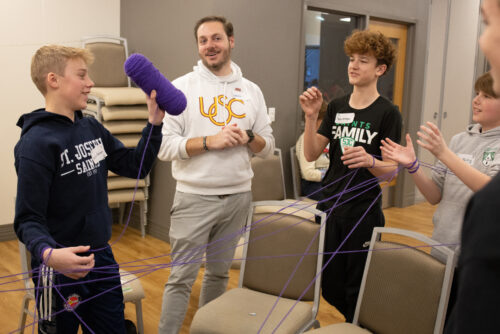
Adult mentor Danny Zink, second from left, worked on a small-group project with, from left, Louis Redmon, Ryan Witthaus and Rory Malloy, all students at St. Joseph School in Cottleville, during a Celebrate Life event Jan. 21.
For eighth graders receiving the sacrament, “it’s often their first encounter with the Lord,” St. Joseph Cottleville youth minister Danny Zink said. “They’ll ask: What do I do?”
Building a prayer routine is important, especially outside of regular Mass attendance. Danny shared several ideas for teens who want to boost their prayer, including:
Make the time: When a teen approaches him and says they want to boost their prayer life, Danny will ask them when they’re praying. Oftentimes, the answer includes going to Mass, so Danny encourages them to think beyond Mass and set aside a specific amount of time and time of day. Maybe it’s 10 minutes in the evening between completing homework and going to bed. “It’s so easy for them to slide into a mindset of, ‘When I get to it, I’ll get to it,’” he said. Making a specific plan will help develop a good habit.
Embrace tech: Teens definitely spend a lot of time on their phones, and using apps such as Hallow or Magnificat are a great way to encourage prayer, Danny said. Other online resources he shares include YouTube channels such as Ascension Presents, LifeTeen and talks from the SEEK conference and Steubenville youth conference.
Get a good Bible: Finding a good study Bible that includes commentary or other footnotes can be helpful when diving into the Scriptures, Danny said. Teens “want to get into Scripture more … but when I talk to them and they’re reading Scripture outside of the Gospels, they’re like, what’s going on,” especially the Old Testament. He recommended study Bibles produced by Word on Fire, LifeTeen and Ascension’s The Great Adventure Bible.
Build Catholic community: As a youth minister, Danny said he wants to know what teens want. “We want to feed them how they want to be fed,” he said. Word Wide Open is a weekly Bible study offered at St. Joseph and the result of high schoolers who approached him and said that while they attend Mass, they don’t always understand the Scripture readings. Because of the world they live in, they desire a Catholic community and want Catholic friends, Danny said. “They’re looking for a safe place to be a Catholic. Encouraging them to get involved more directly … will help them grow spiritually.”
This is the third in a six-part series on keeping prayer alive in the home. The series also will explore ways to foster prayer with adults, multi-generational families and seniors.
Part 4: Prayer for the empty nester
In 36 years of marriage, with seven children ranging from 18-33 years old and nine grandchildren, Kay and Paul Halfmann have the real-life experience to know what works — and what doesn’t — when it comes to nurturing a prayer life.

The Halfmanns launched D:6 Ministries in 2020 to equip parents with the tools to pass on the Catholic faith to their children and to cultivate a culture of prayer within their families.
Now as empty nesters, the Halfmanns continue to nurture that sense of prayer within their marriage with some practical approaches:
Keep it small: Small faith groups are an excellent way to strengthen individual prayer life, the Halfmanns said. Finding other people who are in the same place in life and walking together in prayer can bolster prayer at home.
Passing prayer to the next generation: Kay Halfmann’s mother often prayed with her children using a simple blessing as she touched their foreheads: “Remember who you are,” she would say, with the child answering, “A child of God.” Now Kay practices that with her own grandchildren. “They all know what it is,” she said.
Pray as a couple: In 2023 at the SEEK conference in St. Louis, Kay heard a talk by Catholic speaker Jason Evert, in which he encouraged participants to pray more. The Halfmanns took that to heart and began praying the Rosary together, which has now become their after-dinner ritual. Sometimes they’ll pray it in the car.
Volunteer opportunities: This past year, the Halfmanns’ youngest child moved out to go to college. With some extra time on their hands, the Halfmanns decided to give it to their parish through volunteering, including a team that prepares eighth graders for confirmation.
Family Mass attendance: Even with their adult children’s busy schedules (and some living out of town), the Halfmanns often invite them to attend Mass with them at their parish, St. Joseph in Imperial. “It’s nice to see multi-generational families coming together for worship,” Paul said.
This is the fourth in a six-part series on keeping prayer alive in the home. To read the other parts of the series, visit www.stlouisreview.com/story/prayer-alive-in-the-home/
Part 5: Prioritizing prayer
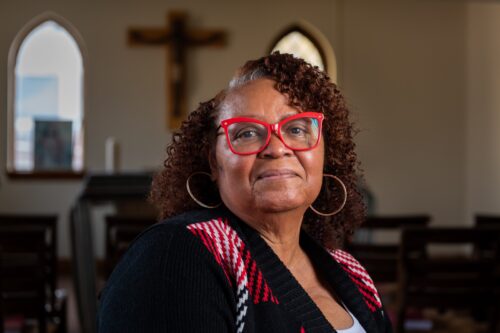
As the mother of four adult daughters, 14 grandchildren and three great-grandchildren, Brenda Vanderford has passed on a lot of wisdom over the years.
The member of St. Peter Claver Parish in St. Louis encourages her family to stay active and engaged in faith through example and these insights:
Don’t be a benchwarmer: The key to staying active in the faith is to do more than just sit in the pew at Mass on Sundays, Brenda said. Participate in the choir, become an altar server, join a Bible study or get involved in other parish ministries. “You cannot be a benchwarmer — you have to be involved in church activities,” she said.
Make Sunday a day for the Lord: Brenda grew up in a southern Baptist household until she became Catholic as an adult in the 1960s. “On Sundays, we didn’t cook, iron or go to the store,” she said. “My mom cooked on Saturdays so we had Sunday available to do church. Our parents emphasized that you should be grateful for what you’ve done and had all week. It’s a time for gratitude. Now (people) do so much on Sundays and church is not a priority. I am still rooted in the fact that my day is not completed until I have gone to Mass.”
Get familiar with the Bible: Brenda still has her late mother’s well-worn Bible, which serves as a reminder of prioritizing Scripture. “She read the Bible all of the time and put dates of birthdays and marriages in it,” she said. Her mother also could recite Scripture passages from memory. “I tell them, get you a Bible and read it. It’s important, because these are to be our guidelines for living our lives. Reading Scripture is so important.”
Communicate prayerfully: Family gatherings at the holidays always start with prayer, Brenda stressed. “We spend all of them together, and they look forward to coming together as family time,” she said. With busy lives both here and out of town, Brenda and her family keep in touch by phone call and text. “We like being prayerful with texts, especially when there is something (happening in their lives) that is joyful or exciting,” she said. “They know that God was in charge of it or helped them get what they need.”
This is the fifth in a six-part series on keeping prayer alive in the home. Read the first part, as well as subsequent parts when they are published, at www.stlouisreview.com/story/prayer-alive-in-the-home/
Part 6: Gratitude, daily reflection are keys to being grounded in prayer

Gratitude and daily reflection are central to Bob and Mary Alice Helmsing’s prayer life.
The Helmsings, who have four grown daughters, 14 grandchildren and three great-grandchildren, say that prayer finds its way into their daily activities, whether it’s a simple “Bless us O Lord” before a meal or through acts of service for others.
Starting the day with daily Mass or going to eucharistic adoration are simple ways to help extend prayer into the home, said the members of St. Clement of Rome Parish in Des Peres. The two shared other ways in which they keep prayer alive in the home:
Learning with grandchildren: The Helmsings love to connect with their grandchildren when they stop by their house on the way home from school. “When they have a project or a paper or anything, they’re very willing to open up and ask us what we think,” depending on the subject, which could include moral issues, prayer or the saints, Mary Alice said.
The Helmsings also enjoy listening to contemporary Christian music with their grandchildren while they’re in the car. “They try to teach us the modern prayer way of praying through music that they like,” she said.”It’s different than what we grew up with, and yet, they can really relate to it.”
Service as a prayer: Service is another form of prayer, the Helmsings said. Whether they are making sandwiches for the St. Patrick Center or helping with a project for the Society of St. Vincent de Paul, “we invite the kids to go with us, and they always do, and they’re always happy to go and figure out what the next adventure is,” Mary Alice said.
The Ignatian way: Before they go to bed, the Helmsings will do the Daily Examen, a prayer practice rooted in Ignatian spirituality to help discern God’s presence. The couple also recommends “Three Moments of the Day: Praying with the Heart of Jesus,” by Father Chris Collins, SJ, in which he focuses on the morning offering, evening reflection and how to ponder the gift of the Eucharist throughout the day.
“It’s really with that focus of gratitude,” Bob said. “If you go to bed every night and you really think about all the good things that happen, there’s so many of them every day that you really almost forget the bad.”
A special prayer for vocations: Through their involvement with the Serra Club of St. Louis, an organization that promotes vocations to the priesthood and the religious life, the Helmsings have found that the discussions are another good way to bring prayer into their lives. Speakers have included priests and sisters who share their vocation stories and ways to encourage vocations in others. “It’s just opportunities for conversation, and conversation is a form of prayer,” Bob said.
This is the final in a six-part series on keeping prayer alive in the home. Read the first part, as well as subsequent parts when they are published, at www.stlouisreview.com/story/prayer-alive-in-the-home/

